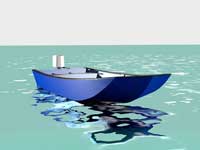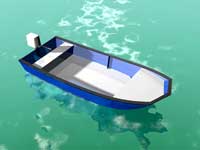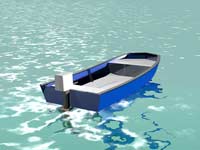It has been a year since I put up the article on
the two, economy Jonboats; Swamper
and Swamp King. Those boats were drawn
to address a very simple and practical approach to
a thin water utility skiff and there has been a very
nice response from readers seeking plans.
Just a couple of weeks ago, I got an email from a
boating enthusiast asking if I had ever designed a
tunnel hull boat along the lines of the Swamper. He
indicated that he had seen a boat something like that
which had been designed for very thin water work.
The boat in question was a full 20’ in length
and he felt that the size would be just too much for
one guy to either pole around or man- handle in any
kind of windy situation. So, he was asking if I had
one like that about 16’ long.
 |
I felt that
the XF20 was quite a nice boat in every respect
except that I had a customer who was asking
about one for his needs, which needed to be
4 feet shorter. |
It turned-out that I did not, but weirdly enough,
I had been tossing an idea around very much like his
request for some time. He was kind enough to direct
me to the www.bateau.com
website where I could take a look at the fine design
work of Jacques Mertens and his XF20
design.
To be completely candid, I felt that the XF20 was
quite a nice boat in every respect except that I had
a customer who was asking about one for his needs,
which needed to be 4 feet shorter. I had already designed
a full-tilt, 18’ vee hulled flats machine for
fast runs across open, choppy bays and thin water
poling sessions. So, I took many of the ideas I had
in the Flatsmaster design and the Swamper series and
combined them with the really nice elements of the
XF20 to create the Blackwater 16.
 |
This is a pocket
tunnel hulled boat with a wide stance that can
support two fishermen and all their gear in
very, very thin water. |
This is a pocket tunnel hulled boat with a wide stance
that can support two fishermen and all their gear
in very, very thin water. The hull has defined, 8
degree vee sections up front to help break some of
the light chop one might find on backwater sessions
in the late afternoon. The run aft from amidships
is very nearly flat to allow the boat to plane easily
with a very small outboard.
Because of this choice of bottom shapes, this boat
will be a lot more fun if you try to take it across
a choppy body of water at speed. The forward vee shape
of the hull will allow for faster speeds in open water
as it will help to cut through the waves rather than
bounce over them. As a swamper’s poling machine,
it will excel in the narrow backwaters and thin mangrove
estuaries where some really prize fish hang out, well
out of reach of conventional fishing boats.
If you want to take this boat into the Bayou and
hunt for a pig, you’ll find that the hull can
carry a very sizeable load with ease. I can really
see this design as perfect for a duck hunter. Just
rig a short mast in the center of the hull and hang
a camo net over the gunnels and you have room to spare
underneath for your cooler, your gun selection and
the battery powered TV with earphones.
 |
If you want
to take this boat into the Bayou and hunt for
a pig, you’ll find that the hull can carry
a very sizeable load with ease. |
I’m not going to go into the technical description
of the pocket tunnel, as there is a wonderful paragraph
on the functional aspects on the Bateau site. Needless
to say, the tunnel allows the engine to be raised
up higher than normal giving additional clearance
in the water for the prop to run in shallow water.
This means you can go further into the creeks in your
boat while using the engine. That translates to being
able to stay out longer and come home later because
of the additional speed over a poled boat in really
shallow water. I figure nearly four additional inches
of water depth before you’ll have to shut it
down and paddle compared to a conventional Jonboat.
I suggest that you don’t exceed 30 hp for an
outboard on this boat so that you can maximize the
potential of the thin water capability. It’ll
run surprisingly good with a 10-20-hp engine and in
thin water and tight quarters, a lot of power would
just go to waste, anyway. There’s a tendency
to install too big an outboard on most recreational
boats. I’m hoping that most folks recognize
that a lighter, more efficient engine is actually
better all around for 90% of all the boating work
you will need to do.
 |
There is a
lightweight framework truss in the hull beneath
the deck to give the boat longitudinal strength. |
Construction of the boat is in stitch and glue style
with 3/8” hull bottom panels, deck, seat and
fishing surfaces and ¼” plywood everywhere
else save the transom. There is a lightweight framework
truss in the hull beneath the deck to give the boat
longitudinal strength. The suggested bench seats and
forward fishing platform also serve as flotation chambers
to keep the boat afloat in case it is swamped. The
builders of this boat have the potential to build
the interior out anyway they would like beyond the
supplied bench seat design, but the more they add,
the heavier the boat gets and that starts to take
away the thin water capability of the design.
As shown in the illustrations, there is a midships
frame and a continuous surface deck. Under the deck
are two, full length stringers. These additions provide
for a near bullet-proof hull with an added benefit.
If the hull skin were to be holed from an unseen underwater
obstacle, the flooding would be confined to the area
of the damage as the compartments under the deck are
sealed from one another to provide flotation integrity.
Yes, the boat is a little heavier, but the payoff
is in the enhanced safety, and hull rigidity if you
decide to take it up to faster planing speeds.
 |
Plans will be
available in the next month and will run USD$75.
They include full-sized paper templates and
detailed instructions regarding any of the stuff
that is not straightforward. |
I suggest that the boat be built with epoxy taped
seams inside at all joints with a full layer of epoxy
glass on the outside of the hull. Prudent builders
will add a layer (or two) of extra glass at all the
sharper, hard corners to protect them from the inevitable
banging a boat of this type will receive during use.
This is an easy boat to build and it will provide
hundreds of hours of enjoyment for the owner, especially
after he customizes the interior to suit his favorite
applications and fits-out the boat with all the trick
goodies for his recreational passion.
Plans will be available in the next month from Duckworks
and will run USD$75. They include full-sized paper
templates and detailed instructions regarding any
of the stuff that is not straight forward, simple.
There is also a suggested layout map for nesting the
panels efficiently. The templates allow you to simply
scarf together the ends of the full sheets of plywood,
layout the templates, trace a line around the edges
and start cutting the hull panels. No lofting required
and quite a bit of time saved plotting points and
bending sticks.
Chris Ostlind
Lunada Design
Chris@Wedgesail.com

Articles by Chris Ostlind:
|